Is It Too Soon for Olympic Lifts?
![]()
CrossFit has caused a dramatic increase in the use of Olympic weightlifting in strength and conditioning programs. While the Olympic lifts are without a doubt one of the best ways to develop explosive strength and power, they are extremely technical and can be complicated to learn. Due to their complexity, these lifts can become dangerous when used inappropriately.
As coaches, our No. 1 goal is to reduce the risk of injury in our athletes. Before implementing these lifts into a strength and conditioning program, you must first make an educated decision as to whether they are appropriate for the athlete and whether or not there is a safer yet closely related alternative.
Just like sprinting, jumping and other explosive exercises, there is a time and place to employ Olympic lifts as well as risks associated with each exercise. There is no doubt that Olympic lifting is a great way to increase explosive speed, power and strength, but at what cost? The athletes on your team will never be able to exhibit that strength or power on the field if they get injured while training.
For example, a Division-III freshman lacrosse player with zero experience in the weight room should not have a Snatch complex or max effort Overhead Squat in his program. Chances are the athlete does not have the flexibility or mobility to get his arms in the proper position overhead, let alone have enough strength to hold the bar there. Just because you want every player on your team to Clean, doesn’t mean every player on your team should.
So how do you ensure your athletes do not get hurt while obtaining explosive speed, power and strength they all desire? Here are the steps we take at O.B. Training and Sports Performance. Check out the video playlist above to see a demonstration of each assessment and exercise mentioned below.
Assess Your Athletes
We use the Functional Movement Screen to assess all of our athletes. This tool gives us an objective understanding of an athlete’s movement capabilities and restrictions. We then determine which exercises the athlete can/will perform in his or her individual program. Athletes with poor shoulder and hip mobility will not be cleared to practice the Olympic lifts until these issues are corrected. Even though there may be a general template for a team, each individual athlete may need different exercises programmed based on his or her capabilities. Otherwise, their training program can be ineffective and possibly dangerous.
Two Quick Assessments
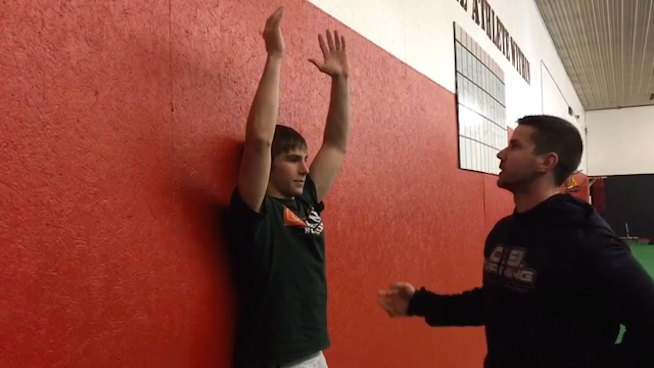
Shoulder Assessment: Have your athlete stand with his back against a wall. Make sure he keeps a neutral spine and maintains all points of contact. Instruct him to reach his arms directly overhead without compromising his position.
- What to look for: Can the athlete get his arms overhead without sacrificing a neutral spine? Does he have the thoracic spine mobility to get his hands there? Can he reach the front rack position?
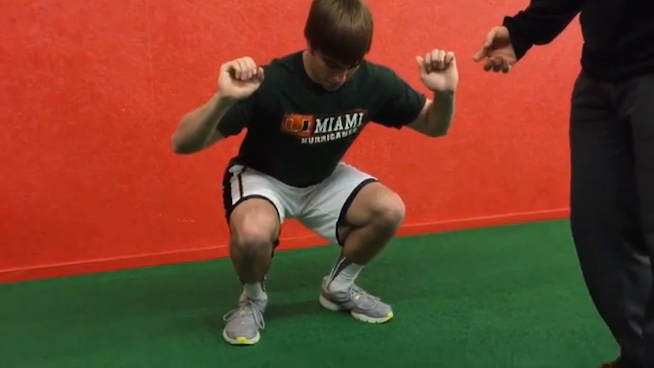
Hip Assessment: Have the athlete squat as deep as they can.
- What to look for: Can he do a deep Squat? Can he keep his torso vertical in the bottom position? Do his heels come off the ground? Do his knees cave in?
Safer Olympic Lift Alternatives
There are safer exercises to use to mimic the mechanics of Olympic lifts. Specifically, we are trying to replicate the explosive triple extension movement shown above. This can be done using a variety of implements that will be more suitable for athletes with movement restrictions.
Single-Arm DB Snatch
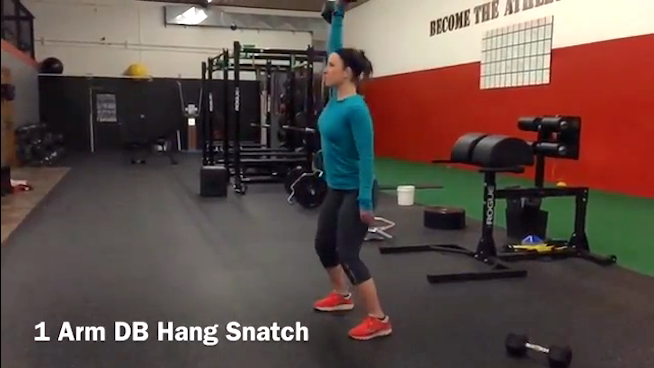
It is more likely that an athlete will be capable of reaching one arm directly overhead. This is why the Single-Arm Dumbbell Snatch is a great alternative to the classic Snatch. The athlete only has to focus on getting one arm overhead in the proper position at a time, allowing for proper technique.
Medicine Ball Scoop Throw
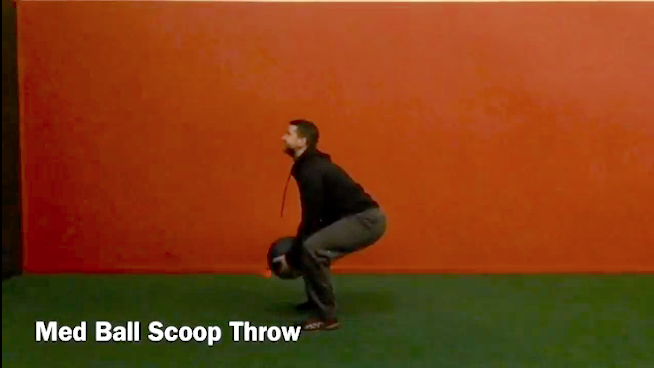 The medicine ball scoop throw is another way to replicate the triple extension movement pattern. Also, this exercise has a very small learning curve and is simple to teach and implement in large groups. The athlete is simply going to grab a medicine ball and launch it backwards over his or her head.
The medicine ball scoop throw is another way to replicate the triple extension movement pattern. Also, this exercise has a very small learning curve and is simple to teach and implement in large groups. The athlete is simply going to grab a medicine ball and launch it backwards over his or her head.
Dumbbell Clean and Jerk
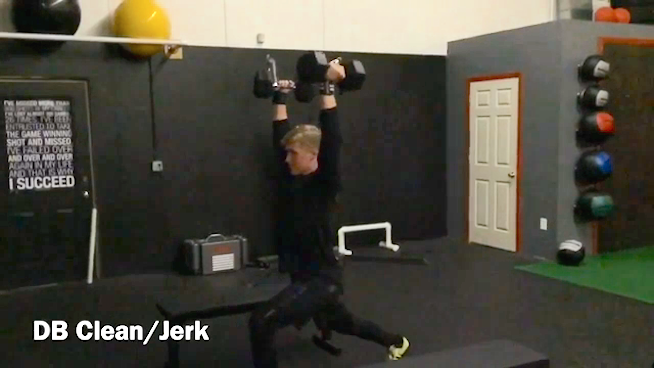
Allowing the arms to move independently of each other will help anyone who is unable to reach the front rack position with a bar. This will also help with getting both arms directly overhead on the jerk.
RELATED: Alternatives to Olympic Lifts for Power Development
[cf]skyword_tracking_tag[/cf]RECOMMENDED FOR YOU
MOST POPULAR
Is It Too Soon for Olympic Lifts?
![]()
CrossFit has caused a dramatic increase in the use of Olympic weightlifting in strength and conditioning programs. While the Olympic lifts are without a doubt one of the best ways to develop explosive strength and power, they are extremely technical and can be complicated to learn. Due to their complexity, these lifts can become dangerous when used inappropriately.
As coaches, our No. 1 goal is to reduce the risk of injury in our athletes. Before implementing these lifts into a strength and conditioning program, you must first make an educated decision as to whether they are appropriate for the athlete and whether or not there is a safer yet closely related alternative.
Just like sprinting, jumping and other explosive exercises, there is a time and place to employ Olympic lifts as well as risks associated with each exercise. There is no doubt that Olympic lifting is a great way to increase explosive speed, power and strength, but at what cost? The athletes on your team will never be able to exhibit that strength or power on the field if they get injured while training.
For example, a Division-III freshman lacrosse player with zero experience in the weight room should not have a Snatch complex or max effort Overhead Squat in his program. Chances are the athlete does not have the flexibility or mobility to get his arms in the proper position overhead, let alone have enough strength to hold the bar there. Just because you want every player on your team to Clean, doesn’t mean every player on your team should.
So how do you ensure your athletes do not get hurt while obtaining explosive speed, power and strength they all desire? Here are the steps we take at O.B. Training and Sports Performance. Check out the video playlist above to see a demonstration of each assessment and exercise mentioned below.
Assess Your Athletes
We use the Functional Movement Screen to assess all of our athletes. This tool gives us an objective understanding of an athlete’s movement capabilities and restrictions. We then determine which exercises the athlete can/will perform in his or her individual program. Athletes with poor shoulder and hip mobility will not be cleared to practice the Olympic lifts until these issues are corrected. Even though there may be a general template for a team, each individual athlete may need different exercises programmed based on his or her capabilities. Otherwise, their training program can be ineffective and possibly dangerous.
Two Quick Assessments

Shoulder Assessment: Have your athlete stand with his back against a wall. Make sure he keeps a neutral spine and maintains all points of contact. Instruct him to reach his arms directly overhead without compromising his position.
- What to look for: Can the athlete get his arms overhead without sacrificing a neutral spine? Does he have the thoracic spine mobility to get his hands there? Can he reach the front rack position?

Hip Assessment: Have the athlete squat as deep as they can.
- What to look for: Can he do a deep Squat? Can he keep his torso vertical in the bottom position? Do his heels come off the ground? Do his knees cave in?
Safer Olympic Lift Alternatives
There are safer exercises to use to mimic the mechanics of Olympic lifts. Specifically, we are trying to replicate the explosive triple extension movement shown above. This can be done using a variety of implements that will be more suitable for athletes with movement restrictions.
Single-Arm DB Snatch

It is more likely that an athlete will be capable of reaching one arm directly overhead. This is why the Single-Arm Dumbbell Snatch is a great alternative to the classic Snatch. The athlete only has to focus on getting one arm overhead in the proper position at a time, allowing for proper technique.
Medicine Ball Scoop Throw
 The medicine ball scoop throw is another way to replicate the triple extension movement pattern. Also, this exercise has a very small learning curve and is simple to teach and implement in large groups. The athlete is simply going to grab a medicine ball and launch it backwards over his or her head.
The medicine ball scoop throw is another way to replicate the triple extension movement pattern. Also, this exercise has a very small learning curve and is simple to teach and implement in large groups. The athlete is simply going to grab a medicine ball and launch it backwards over his or her head.
Dumbbell Clean and Jerk

Allowing the arms to move independently of each other will help anyone who is unable to reach the front rack position with a bar. This will also help with getting both arms directly overhead on the jerk.
RELATED: Alternatives to Olympic Lifts for Power Development
[cf]skyword_tracking_tag[/cf]











